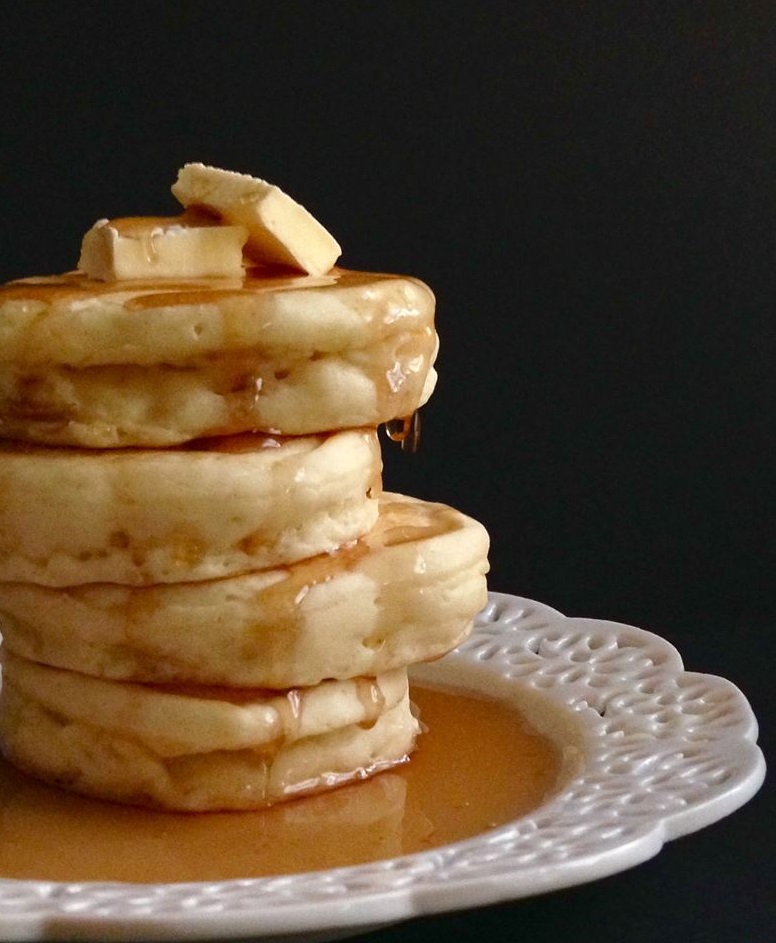
Some of my favorite childhood memories can be traced back to Saturday mornings. Our best friends and neighbors, Dave and Shina, would often spend the night Friday, after school, and after epic sleepover fun (camping, S’mores, and fishing trips, complete with bicycle rides), we always had Saturday morning breakfast to look forward to. My Mom always had a fantastic breakfast for us, Saturday morning. Across the board, our favorite breakfast was her pancakes. They were thick and fluffy, light as a feather, and, of course, they tasted incredible. Garnished with real maple syrup, they were to die for. Even to this day, tasting these pancakes takes me back to those amazing, carefree days, when we could do anything and pretend to be anything we wanted, with our best friends by our side.
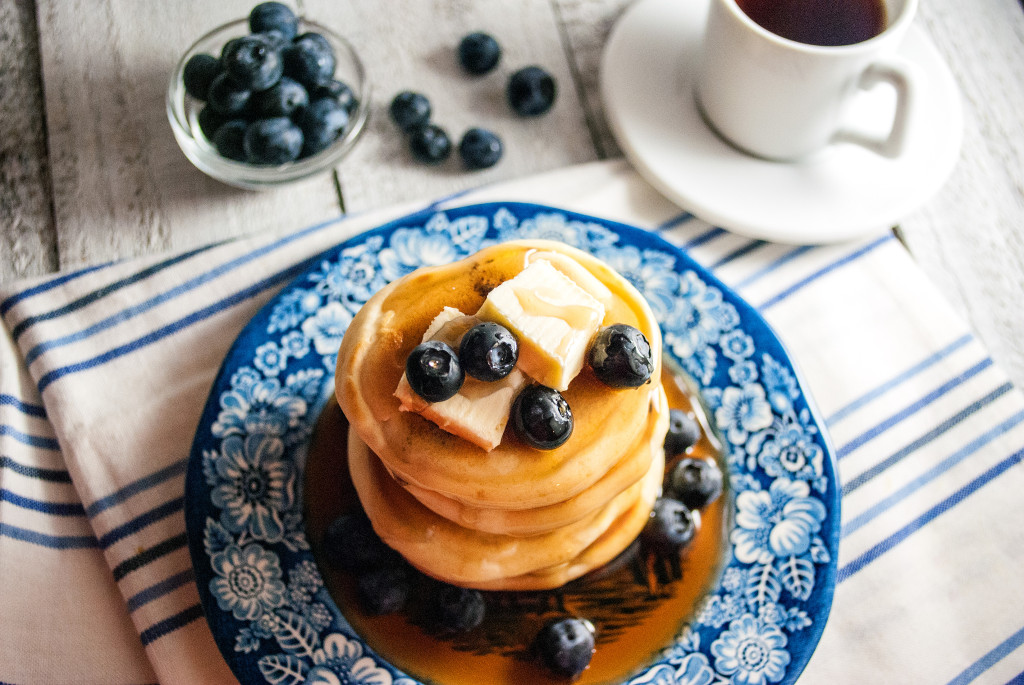
Why don’t you make these pancakes, this weekend, and start your own family traditions? After all . . . anything made with love is the stuff from which memories are made. And if that memory is drizzled with delicious, warm maple syrup? Well . . . that’s just window dressing 😉
What are we waiting for? Let’s do this!
Classic Breakfast Pancakes
(Original recipe from Better Homes and Gardens and adapted by me)
Ingredients:
2 1/2 cups all purpose flour
2 tbsp. baking powder
2 tbsp. sugar
2 beaten eggs
2 cups milk
1/4 cup vegetable oil
Directions:
Mix dry ingredients together with a whisk. Add wet ingredients all at once and whisk until combined. Bake pancakes in a medium low skillet until brown.
Now, in pictures! 🙂 And don’t forget to check out my new book, Sunny Days and Sweet Tea, which featured these delicious little pancakes on the book cover 😉
First, take your dry ingredients (flour, baking powder, sugar) and whisk them together. The whisk just makes sure that everything comes together just right. I wish I could just “whisk” my life, sometimes, and help everything come together! 😉
Next, take your 2 eggs and whisk them with a fork. I use the same cup measure for everything– it saves dishes! After I use it for the dry ingredients, I whisk my eggs in there. Whisking the eggs just helps them to mix into the batter, better, so that you don’t get a random chunk of scrambled egg in your pancakes. Although . . . pancakes and eggs might be an idea . . .
Place your beaten egg into a well (a simple hole you dig out with a wooden spoon– don’t overthink it) and add the eggs into the center. Add in your 2 cups of milk and the 1/4 cup oil. Gently whisk in the wet ingredients until the batter is combined.

Now, I’m going to tell you something that goes against everything in the “pancake making Bible.” Most people tell you that the batter should *just* be moistened– that if you overstir, the batter will make super tough pancakes that you can almost use to pound in a nail. Wellllll . . . I beg to differ, but that hasn’t been my experience. In my humble opinion, I don’t think it’s necessarily overstirring that makes tough pancakes . . . I think it’s using heat that is too high.
My “unofficial pancake law” is this:
Understirred batter + high heat = blackened, rubbery pancakes
Well stirred, thick batter + extra time and + low heat = light, fluffy, thick pancakes
I know you’ve seen it . . . you’ve ordered pancakes, somewhere (or made them, yourself), and they come out super thin (like, a stack of 4 would make a doable bite when you cut into it), and they have kind of a tough shell on the outside, and it’s super dark in color. Eeeewwwww. I hate pancakes like that. I like my pancakes to be about 3/4 inches tall, light as a feather, and a delicate golden brown color, with a soft consistency, throughout– like snacking on a cloud 😉 To get your pancakes to look like this, do 2 things for me . . . make your batter extra thick, and turn your heat extra low. Because I’ve been jabbering so much, I’ve gotten away from the picture, up there, but if you look at the picture above all my explanation, look at how thick the batter is. See? It’s literally so thick that, when I lifted the whisk out of the bowl, the batter is almost like volcanic magma as if falls back into the bowl. It’s almost the consistency of bread dough before you knead. And here’s another secret . . . I add more flour than the recipe calls for. That’s right. My basic recipe is fine, and it makes great pancakes . . . but after I get all that flour in there, I carefully add a little more, little by little (about 1/4 cup at a time) until the batter bends my whisk when I whisk it. I’m serious. It will actually bend my metal whisk a little bit while I mix. That’s the thickness you’re looking for.
Now, let’s talk heat. Your skillet shouldn’t go any higher than 3.5, no matter what kind of skillet you’re using. If you’re using cast iron, start at 3 and you can possibly even get away with 2.5 on the dial. Cast iron holds its heat, so I generally start with a heat of 3 and turn it down to 2.5 once the skillet gets fully warmed. Standard pancake know-how has a super high temperature in the skillet, and the batter kind of “sizzles” when you drop it onto the pan. That’s fine to do, but realize your pancakes will be very dark and have almost a “grilled” taste. For light and soft pancakes, you need low heat.
I like to use a muffin scoop (more on that and where to purchase one here) to make my pancakes. It hangs nicely on the bowl, so there’s no mess, and it also makes all the pancakes the same size and (relatively) uniform, which is great. Use a little cooking spray on your skillet, at first, to make sure that they don’t stick. I, generally, don’t have to re-spray after the first set of pancakes (the low heat doesn’t make the batter stick like the high heat does), but if your pancakes start to stick, you may need to re-spray.
Now here’s the kicker . . . low heat takes longer. Yes. It does. Don’t try to speed them up and turn up the heat. You’ll end up with burned outsides and raw insides. These pancakes need to sit for a good 7-8 minutes per side. Don’t keep lifting the pancakes up, to see if they’re done. This will destroy them and that gorgeous brown color you are trying to create! Instead, watch the tops. Don’t disturb them . . . just watch the tops. When the tops start to look like this– almost like they have a little hardening “shell” on the top and sides (not wet looking, anymore), they are almost there.
The top will have lost the shiny wet look, and they will have bubbles kind of frozen into them, because the dough is slowly baking. You can gently touch them, and no batter will come off on your finger. This pancake technique is great if you have a big breakfast to prepare, because you can almost forget about these pancakes and then come back and flip them when you remember. Because they are cooking so slowly, it’s almost impossible to burn them. (I said “almost”– don’t leave them forever, or it does happen 😉 But it’s much harder to burn these than traditional pancakes).
When the tops look dull, with those stationary bubbles in them, gently flip the pancakes. They should have a kiss of brown and be super fluffy and thick. Your second side doesn’t take nearly as long, because the first side’s baking got most of the middle finished, for you. The second side takes maybe 1/2 the time of the first. And you can check these after a few minutes and “peek” at the bottoms to see if they’re brown. Because the pancake is mostly cooked in the middle, moving it around a little, at this point, isn’t going to hurt. When the bottom is nice and golden brown, move the pancakes to a cooling rack. Generally, at my house, they magically disappear, at this point . . . but if you have any left over, allow them to cool, completely, and then freeze them. They taste just as amazing microwaved the next day– they don’t toughen up like regular pancakes do, because they are so soft inside.
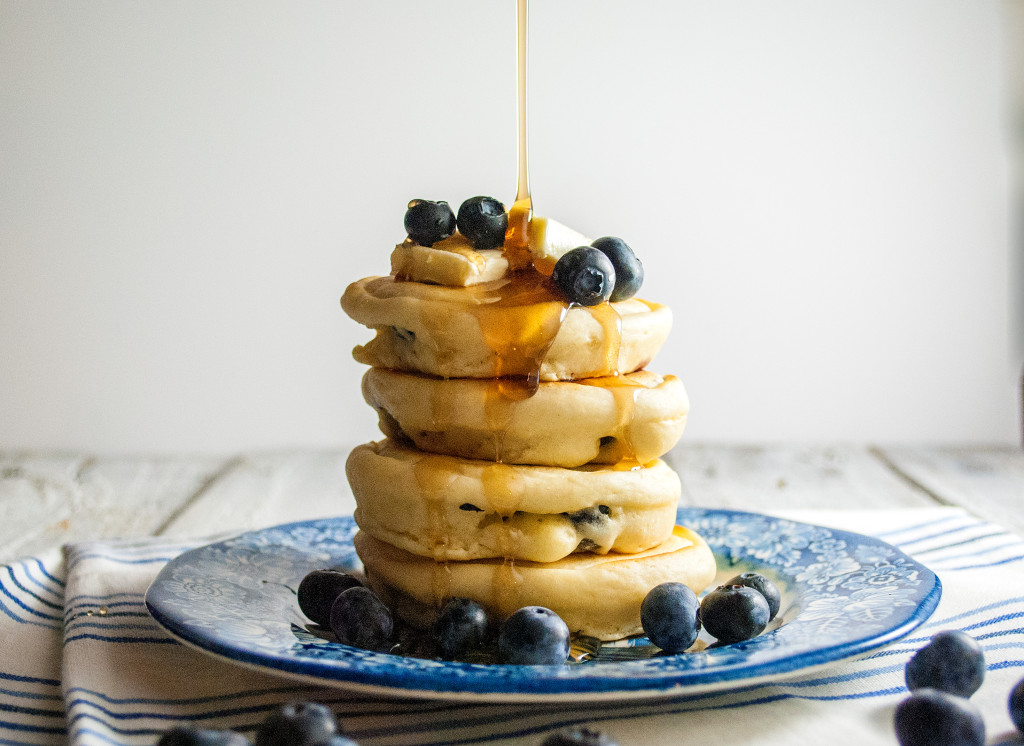
And if you make them Silver Dollar pancakes (my toddler loves these), you can have your own, adorable little “stack.” Garnish with blueberries, chocolate chips . . . or just classic butter and LOTS of maple syrup. 😉 Any way you prefer them, they are awesome– pillowy clouds of softness that soak up the syrup and beg for more. And microwaved out of the freezer, they are just as soft, and just as good. Goodness. It’s wonderful. I love to send individual frozen pancakes in my husband’s lunch so that he can have a nice, hot breakfast when he gets to work. Just FYI, baby food containers make great “syrup vessels.” 😉 Hey– we do what works.
He buys me Le Creuset, and I make him pancakes. What can I say. It must be love.
You did it! And I’m just so proud of you. 🙂

Disclosure: This post may contain affiliate links, which just means that we get a few pennies if you purchase through our link. I never recommend products that I don't personally use and love. Thanks!
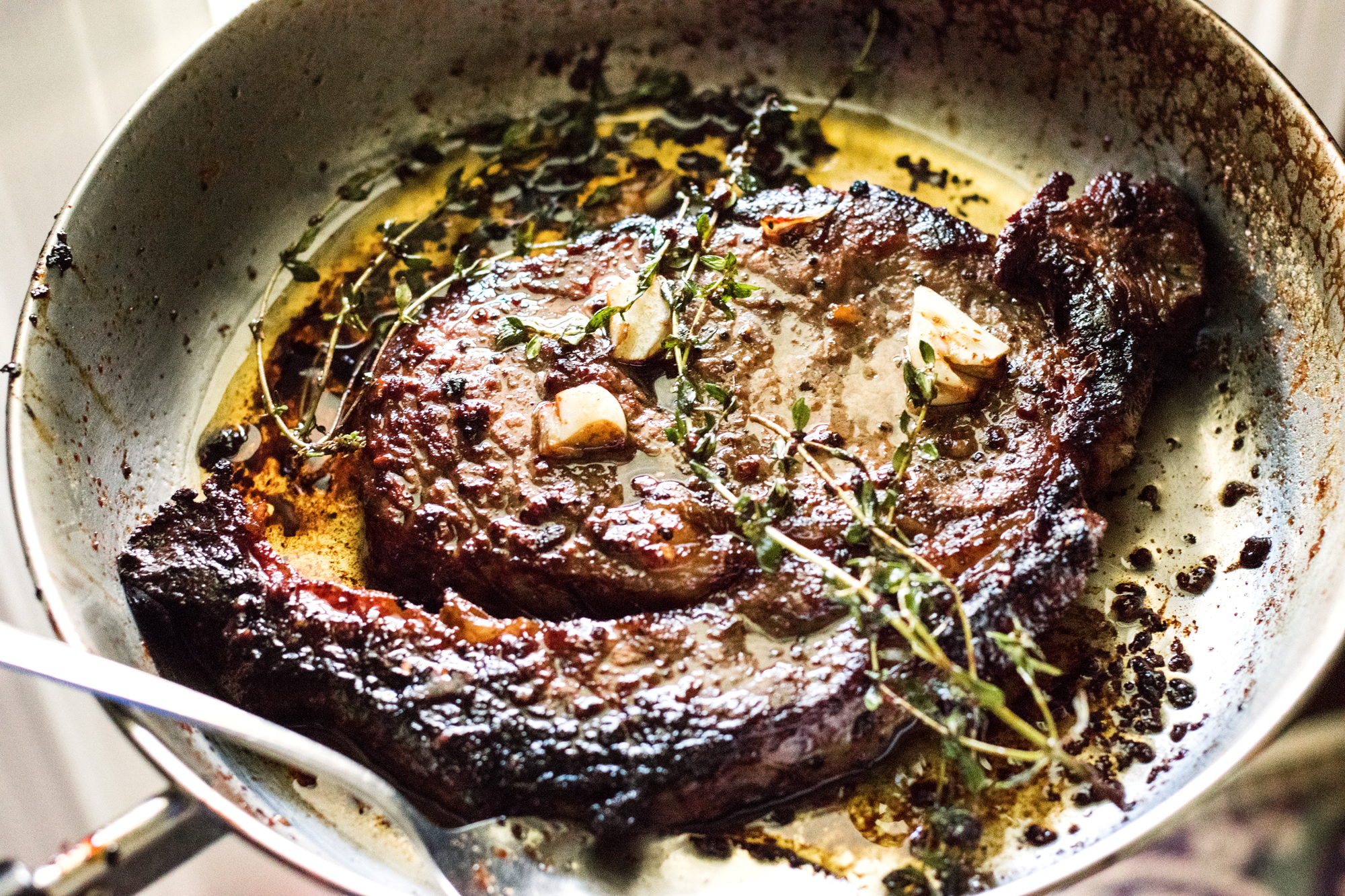








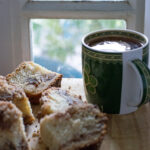
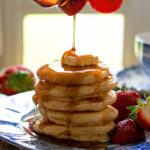
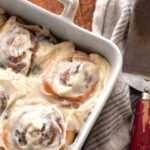

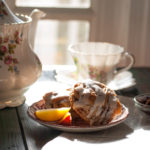

Pingback: Fluffy Chocolate Chip Pancakes – Cookies for England
Pingback: Skinny General Tso's Chicken – Cookies for England
Im not sure ive seen this one, but love reading the first part, like you said eating the pancakes bring you back to those days, and reading this brought me back! Thanks Emilie!!
You don’t need to read it, Dave– you’ve LIVED it! 🙂
This is incredible pancake batter for making thick fluffy panckakes! I used a small cast iron, making one large pancake at a time, I put it on med low, preheated it, buttered it, then filled it with a half inch of this batter, I came out with moist fluffy pancakes over and inch thick. Very good. I used coconut oil for my oil that I added to the batter. For such a thick batter it cooks through very well.
Oh, I am SO with you on the cast iron! Once I started using the CI, I never looked back! The “huge pancake” idea sounds incredible. I need this in my life. hehe. 🙂 And coconut oil, too! What great ideas! Thanks for stopping by and sharing them! 🙂
Such good memories- made me think back to similar weekends in my own home as a child. These pancakes are so fluffy- they melt in your mouth! Definitely a keeper!
Thanks, Megan! I agree– they are delish! 🙂
These are perfect for a dinner meal also when you want a change. They were delicious in the PM as well as the AM; yummy, yummy???
I agree, Connie! I love breakfast for dinner anytime! Yum! 🙂
I always thought my pancake recipe was pretty good, but man I’m throwing it out and only using this one from now on. The pancakes came out so fluffy I actually had to cut one in half, lengthwise, for the baby! Wow! I did add a little extra flour like you say to in your directions so that the dough bent my whisk. Just the best Saturday breakfast we have ever had. Will be making these again and again! Thanks!
Thanks, Shirley! So glad you liked them! I hope you make many more great breakfast memories with your family! Thanks for stopping by! 🙂
I tried making these and they didn’t exactly turn out as fluffy and puffy as the picture shows. I made sure to follow the measurements and procedures and made sure to mix the batter well. Is there anything I might’ve missed? Maybe, you could tell me how long it should be mixed? And, a suggestion on making it a little more moist?
Hi there– I’m sorry you’re having trouble with the pancakes! My suggestion is to check out the pictures in the tutorial to see how thick the batter needs to be– some flours seem to make a thinner batter (I like King Arthur flour best), so you may have to add a little extra flour to make the dough nice and thick– it should actually bend the whisk– that’s how thick you need it to be to make the nice, thick pancakes. With other flours you may have to add an extra 1/2 cup to 1 cup flour to get the batter to the right thickness. I also recommend a low heat– I do mine on about a 2.5-3 on the stove dial. The lower heat keeps the pancakes from getting dry. I hope this helps! If you’re still having trouble, shoot me an email at Emilie@cookiesforengland.com and I’ll be glad to try to troubleshoot with you and see if we can figure this mystery out, for you :). Thanks for stopping by.
How many pancakes can be made from this recipe?
Hi there, Gloriana! I usually get about 10-12 medium pancakes from this recipe, but you can get more if you make them smaller. Happy eating 😉
Looks delicious! Will make it tomorrow. Could I use cottage cheese instead of milk? If so, how much? Thanks!
Hmmm. That’s an interesting question, Mery. I’ve never tried cottage cheese, but I don’t see why it wouldn’t work. If you want to try it, I would substitute it equally (1:1 ratio) for the milk. This needs to be a thick batter, so I think you could swing it. 🙂 Let me know how it turns out . . . now I’m curious! 🙂
Wow!! These are the fluffiest pancakes I’ve ever seen! haha 🙂
I know! haha. It’s almost unreal how puffy and soft they are. The low heat and baking powder do a beautiful waltz in there 🙂
I haven’t made these yet but I think a 16 ounce can of corn (drained) or 8 ounce for half of recipe would make a nice side dish and will do that soon. A thick batter is needed for corn cakes.
What a great idea, JoAnn! I will have to give that a try! YUM!